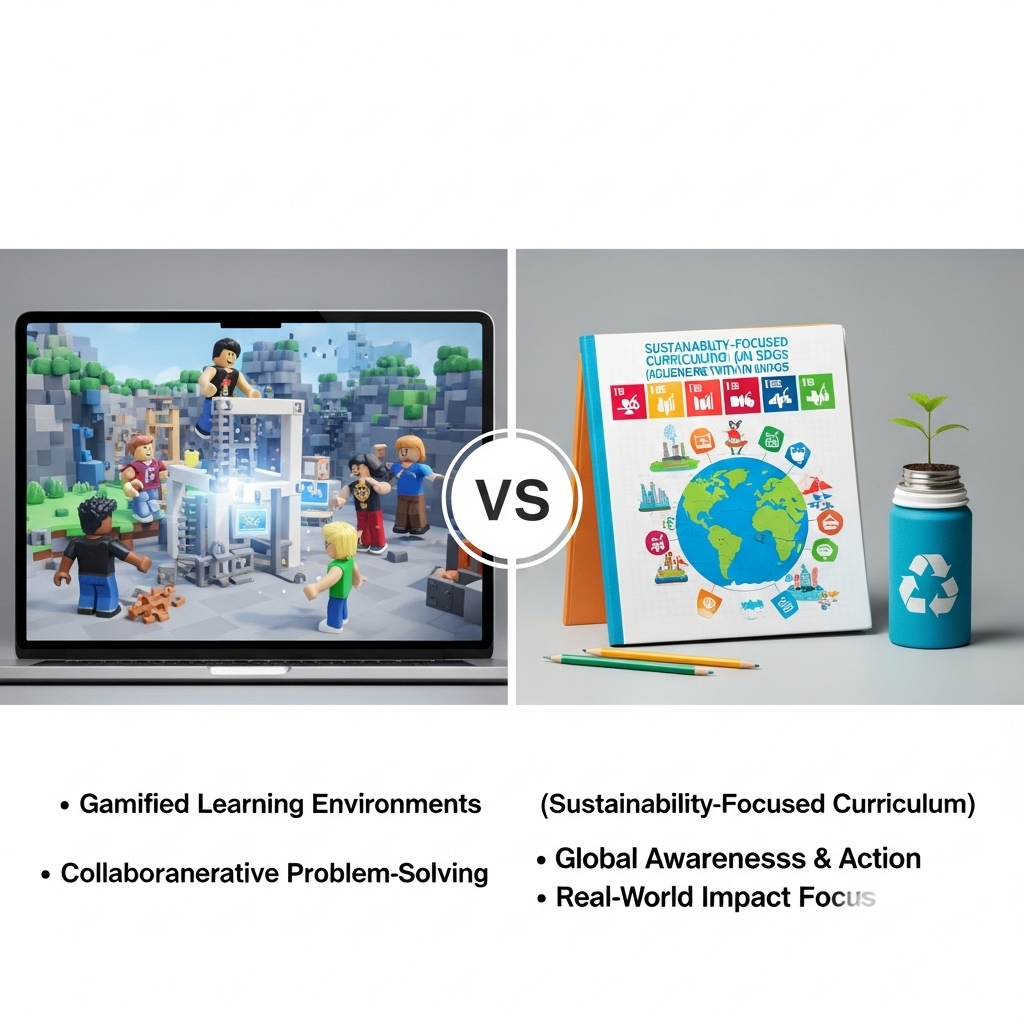Educational approaches: Gamified Learning Environments (e.g., Roblox Education) vs. Sustainability-Focused Curriculum (Aligned with UN SDGs)
Quick Verdict
Both platforms offer valuable educational resources, with Roblox focusing on gamification and real-world applications, while the Sustainability-Focused Curriculum emphasizes sustainability principles and alignment with UN SDGs.
- Roblox Education excels in gamified engagement and real-world simulations.
- Sustainability-Focused Curriculum provides a strong foundation in sustainability topics and aligns with UN SDGs.
- Both platforms offer customization and integration with existing educational tools.

Key features – Side-by-Side
| Attribute | Gamified Learning Environments (e.g., Roblox Education) | Sustainability-Focused Curriculum (Aligned with UN SDGs) |
|---|---|---|
| Curriculum Alignment with Learning Objectives | Aligned to various educational needs, including UK national curricula and K-12 standards in the U.S., Next Generation Science Standards. Subject and grade-level appropriate content. | Ensures students gain knowledge, skills, and values to address environmental, social, and economic challenges. Aligns with broader curriculum standards and sustainability goals, Common Core, and Next Generation Science Standards. |
| Student Engagement Metrics | Leverages gamification with rewards, points, and level progression. Metrics include task completion rate, time per task, error frequency, and interaction depth. | Experiential learning activities, real-world projects. Metrics include participation rates, project outcomes, and qualitative feedback. Hands-on activities, discussions, projects, and real-world applications. |
| Accessibility and Inclusivity Features | Accessible across multiple devices. Supports students with diverse learning needs. | Designed considering age-appropriateness and accessibility for all learners. Personalized learning. Supports students with diverse learning needs. |
| Teacher Training and Support Resources | Resources and training for teachers to integrate the platform effectively. Educational content and creation tools free of charge. | Workshops, seminars, professional development opportunities. Resources may include templates, checklists, and access to supportive communities of educators. |
| Assessment and Feedback Mechanisms | Assessments integrated into gameplay, providing instant feedback and tracking learner behavior in real-time. | Formative and summative assessments. Reflective journals, peer feedback, and iterative project submissions. |
| Real-World Application and Relevance | Connects learning to real-life scenarios through simulations and game development. Used for employee training. | Connects learning to real-world problems through case studies, field experiences, and local data. |
| Integration with Existing Educational Tools | Integration with existing learning management systems (LMS) and other educational tools. | Integrates with existing learning management systems (LMS) and other educational tools. |
| Scalability and Cost-Effectiveness | Cost-effective alternative to traditional training methods. Business model supports scalable educational products. | Information on specific cost per student and how the curriculum scales for larger classrooms or districts is not available in the provided context. |
| Sustainability Content Depth and Accuracy | Aligns with UN Sustainable Development Goals, promoting quality education, decent work, and reduced inequality. | Thoroughly and accurately covers sustainability topics and the UN Sustainable Development Goals. |
| Community and Collaboration Opportunities | Multiplayer options foster collaboration. Team-based challenges. | Project-based learning, community engagement, and partnerships with external organizations. |
| Data Privacy and Security Measures | Committed to safety and civility, ensuring student data privacy and security. | Information on specific measures to ensure student data privacy and security is not available in the provided context. |
| Customization and Adaptability | Highly customizable to meet the specific needs of different classrooms or schools, allowing educators to create tailored learning experiences. | Customizable to meet the specific needs of different classrooms or schools. |
Overall Comparison
Engagement: Roblox wins; Sustainability Focus: Sustainability Curriculum wins; Customization: Both strong
Pros and Cons
Gamified Learning Environments (e.g., Roblox Education)
Pros:
- Curriculum alignment with learning objectives
- Student engagement through gamification
- Accessibility across multiple devices
- Teacher training and support resources
- Assessment and feedback mechanisms
- Real-world application and relevance
- Cost-effective alternative to traditional methods
- Alignment with Sustainable Development Goals
- Community and collaboration opportunities
- Commitment to data privacy and security
- Customization and adaptability
Cons:
- Information on direct integration with specific LMS systems was not found in the provided context.
Sustainability-Focused Curriculum (Aligned with UN SDGs)
Pros:
- Aligns with UN SDGs
- Focuses on sustainability
- Offers real-world application and relevance
- Integrates with existing educational tools
- Provides community and collaboration opportunities
- Customizable and adaptable
Cons:
- Cost and scalability information not available
- Data privacy and security measures information not available
User Experiences and Feedback
Gamified Learning Environments (e.g., Roblox Education)
What Users Love
- No highlights reported.
Common Complaints
- No major complaints reported.
Value Perception
- No value feedback reported.
Sustainability-Focused Curriculum (Aligned with UN SDGs)
What Users Love
- Engaging for students
- Supports diverse learning needs
- Provides crucial teacher support
- Offers effective assessment and feedback
Common Complaints
- No major complaints reported.
Value Perception
- No value feedback reported.